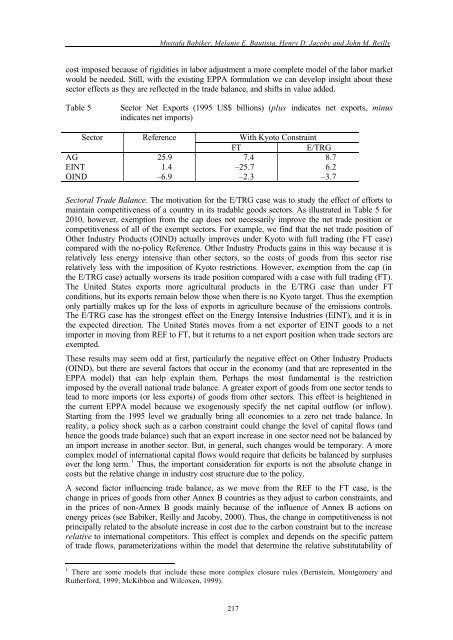sectoral economic costs and benefits of ghg mitigation - IPCC
sectoral economic costs and benefits of ghg mitigation - IPCC
sectoral economic costs and benefits of ghg mitigation - IPCC
You also want an ePaper? Increase the reach of your titles
YUMPU automatically turns print PDFs into web optimized ePapers that Google loves.
Mustafa Babiker, Melanie E. Bautista, Henry D. Jacoby <strong>and</strong> John M. Reilly<br />
cost imposed because <strong>of</strong> rigidities in labor adjustment a more complete model <strong>of</strong> the labor market<br />
would be needed. Still, with the existing EPPA formulation we can develop insight about these<br />
sector effects as they are reflected in the trade balance, <strong>and</strong> shifts in value added.<br />
Table 5<br />
Sector Net Exports (1995 US$ billions) (plus indicates net exports, minus<br />
indicates net imports)<br />
Sector Reference<br />
With Kyoto Constraint<br />
FT<br />
E/TRG<br />
AG 25.9 7.4 8.7<br />
EINT 1.4 –25.7 6.2<br />
OIND –6.9 –2.3 –3.7<br />
Sectoral Trade Balance. The motivation for the E/TRG case was to study the effect <strong>of</strong> efforts to<br />
maintain competitiveness <strong>of</strong> a country in its tradable goods sectors. As illustrated in Table 5 for<br />
2010, however, exemption from the cap does not necessarily improve the net trade position or<br />
competitiveness <strong>of</strong> all <strong>of</strong> the exempt sectors. For example, we find that the net trade position <strong>of</strong><br />
Other Industry Products (OIND) actually improves under Kyoto with full trading (the FT case)<br />
compared with the no-policy Reference. Other Industry Products gains in this way because it is<br />
relatively less energy intensive than other sectors, so the <strong>costs</strong> <strong>of</strong> goods from this sector rise<br />
relatively less with the imposition <strong>of</strong> Kyoto restrictions. However, exemption from the cap (in<br />
the E/TRG case) actually worsens its trade position compared with a case with full trading (FT).<br />
The United States exports more agricultural products in the E/TRG case than under FT<br />
conditions, but its exports remain below those when there is no Kyoto target. Thus the exemption<br />
only partially makes up for the loss <strong>of</strong> exports in agriculture because <strong>of</strong> the emissions controls.<br />
The E/TRG case has the strongest effect on the Energy Intensive Industries (EINT), <strong>and</strong> it is in<br />
the expected direction. The United States moves from a net exporter <strong>of</strong> EINT goods to a net<br />
importer in moving from REF to FT, but it returns to a net export position when trade sectors are<br />
exempted.<br />
These results may seem odd at first, particularly the negative effect on Other Industry Products<br />
(OIND), but there are several factors that occur in the economy (<strong>and</strong> that are represented in the<br />
EPPA model) that can help explain them. Perhaps the most fundamental is the restriction<br />
imposed by the overall national trade balance. A greater export <strong>of</strong> goods from one sector tends to<br />
lead to more imports (or less exports) <strong>of</strong> goods from other sectors. This effect is heightened in<br />
the current EPPA model because we exogenously specify the net capital outflow (or inflow).<br />
Starting from the 1995 level we gradually bring all economies to a zero net trade balance. In<br />
reality, a policy shock such as a carbon constraint could change the level <strong>of</strong> capital flows (<strong>and</strong><br />
hence the goods trade balance) such that an export increase in one sector need not be balanced by<br />
an import increase in another sector. But, in general, such changes would be temporary. A more<br />
complex model <strong>of</strong> international capital flows would require that deficits be balanced by surpluses<br />
over the long term. 1 Thus, the important consideration for exports is not the absolute change in<br />
<strong>costs</strong> but the relative change in industry cost structure due to the policy.<br />
A second factor influencing trade balance, as we move from the REF to the FT case, is the<br />
change in prices <strong>of</strong> goods from other Annex B countries as they adjust to carbon constraints, <strong>and</strong><br />
in the prices <strong>of</strong> non-Annex B goods mainly because <strong>of</strong> the influence <strong>of</strong> Annex B actions on<br />
energy prices (see Babiker, Reilly <strong>and</strong> Jacoby, 2000). Thus, the change in competitiveness is not<br />
principally related to the absolute increase in cost due to the carbon constraint but to the increase<br />
relative to international competitors. This effect is complex <strong>and</strong> depends on the specific pattern<br />
<strong>of</strong> trade flows, parameterizations within the model that determine the relative substitutability <strong>of</strong><br />
1 There are some models that include these more complex closure rules (Bernstein, Montgomery <strong>and</strong><br />
Rutherford, 1999; McKibbon <strong>and</strong> Wilcoxen, 1999).<br />
217
















